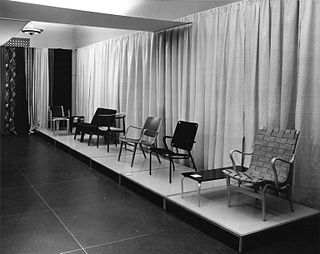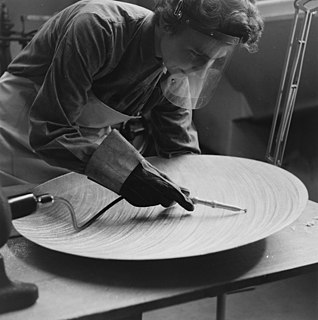Related Research Articles

Arne Emil Jacobsen, Hon. FAIA 11 February 1902 – 24 March 1971) was a Danish architect and furniture designer. He is remembered for his contribution to architectural functionalism and for the worldwide success he enjoyed with simple well-designed chairs.

Scandinavian Airlines, more commonly known and styled as SAS, is the flag carrier of Denmark, Norway, and Sweden. SAS is an abbreviation of the company's full name, Scandinavian Airlines System or legally Scandinavian Airlines System Denmark-Norway-Sweden. Part of the SAS Group and headquartered at the SAS Frösundavik Office Building in Solna, Sweden, the airline operates 180 aircraft to 90 destinations. The airline's main hub is at Copenhagen-Kastrup Airport, with connections to 109 destinations around the world. Stockholm Arlanda Airport is the second largest hub, with Oslo Airport, Gardermoen being the third major hub of SAS. Minor hubs also exist at Bergen Airport, Flesland, Göteborg Landvetter Airport, Stavanger Airport, Sola, and Trondheim Airport, Værnes. SAS Cargo is an independent, wholly owned subsidiary of Scandinavian Airlines and its main office is at Copenhagen Airport.
Poul Kjærholm was a Danish designer. Born in Østervrå, Denmark, Kjærholm began his career as a cabinetmaker's apprentice with Gronbech in 1948, attending the Danish School of Arts and Crafts in Copenhagen in 1952. In 1953, he married Hanne Kjærholm who became a successful architect. While working as a designer, he also became an educator continuing studies with Prof. Erik Herløw and Prof. Palle Suenson.

Scandinavian design is a design movement characterized by simplicity, minimalism and functionality that emerged in the early 20th century, and subsequently flourished in the 1950s throughout the five Nordic countries: Denmark, Finland, Norway, Sweden, and Iceland.

Finn Juhl was a Danish architect, interior and industrial designer, most known for his furniture design. He was one of the leading figures in the creation of Danish design in the 1940s and he was the designer who introduced Danish modern to America.

The architecture of Denmark has its origins in the Viking period, richly revealed by archaeological finds. It became firmly established in the Middle Ages when first Romanesque, then Gothic churches and cathedrals sprang up throughout the country. It was during this period that, in a country with little access to stone, brick became the construction material of choice, not just for churches but also for fortifications and castles.

Charlottenlund is a suburban area on the coast north of Copenhagen, Denmark. It is the administrative seat of Gentofte Municipality. Bordered to the east by the Øresund, to the South by Hellerup and to the north by Klampenborg, it is one of the wealthiest areas in Denmark. The neighbourhood takes its name after Charlottenlund Palace.

Jens Harald Quistgaard was a Danish sculptor and designer, known principally for his work for the American company Dansk Designs, where he was chief designer from 1954 and for the following three decades.

Grete Prytz Kittelsen, was a Norwegian goldsmith, enamel artist, and designer. She is one of the most well-known Norwegians in the Scandinavian Design movement, and has been referred to as the "Queen of Scandinavian Design". Through her work she contributed to internationalisation, innovation and scientific research. She was one of the few Norwegian practitioners who shaped the Scandinavian design style in the post-war era and is the periods’ most renowned Norwegian practitioner. Kittelsen's aim was to make beautiful and user-friendly everyday objects available for everyone. She had a vast and varied production. With her enamelled objects and jewellery she has been a pioneer in design in the post-war era and a model for the next generation of designers. Today her pieces constitute design icons and are sought-after collectables.

Arkitema Architects is a Danish architectural firm headquartered in Aarhus, with branch offices in Copenhagen, Malmö, Stockholm and Oslo. Arkitema Architects was founded in 1969 in Aarhus, and nowadays has about 400 employees with its main activity in Scandinavia.
Steinunn Sigurðardóttir is an Icelandic fashion designer. She is the founder and creative director of the label STEiNUNN, founded in 2000.
Chris Liljenberg Halstrøm is a Danish furniture designer and artist. The daughter of a Swedish mother and a Danish father, she has studied design in both Stockholm, Berlin and in Copenhagen at the Royal Danish Academy of Fine Arts, graduating in 2007. She specializes in furniture design and textile art.

Scandinavian Academy of Fashion Design, often abbreviated to SAFD, is a fashion design school in Copenhagen, Denmark. It offers a full-time three-year fashion design education, and a variety of short and summer courses.
Anne Sofie Madsen Eliasen is an avant-garde Danish fashion designer who grew up on the island of Funen. Initially interested in developing her talents as an illustrator and animator, she later turned to fashion, graduating from the Danish Design School. After training with John Galliano in Paris and Alexander McQueen in London, she established her own label in 2011 and presented her first collection at London Fashion Week the following year.
Lilly Brændgaard Hansen née Jacobsen (1918–2009) was a Danish fashion designer and businesswoman. In 1947, she opened a studio in Vejle where she designed various clothes for women but soon specialized in the more profitable business of wedding dresses. In the mid-1960s, she moved into larger premises in Vejle, founding Denmark's first clothing factory. Established as Kjoleateliet LILLY, over the years her firm became known simply as LILLY. On the occasion of its 50th anniversary in 1997, there were nine outlets in Denmark and 13 in Germany.

Illums Bolighus is a retailer of household furnishings based in Copenhagen, Denmark. The original Illums Bolighus flagship store is located at Amagertorv 10 in central Copenhagen. The company was in 2005 acquired by an investor group headed by CEO Henrik Ypkendanz and has since then opened a number of new stores in Denmark, Norway, Sweden and Germany.
Bitte is a Nordic female given name. Notable people with the name include:
Margrethe (Grethe) Glad née Axelholm (1891–1990) was a Danish socialite, fashion designer and educator. In 1931, she established a fashion and design school in Copenhagen, originally known as Margrethe-Skolen but now renamed the Scandinavian Academy of Fashion Design. During and after the Second World War she became active in charity work both in Denmark and France. She continued to fund charities by selling dolls dressed in historical costumes to museums in the United States and Europe. From 1977, for several years she headed the family firm L.C. Glad & Co..
Louise Lyngh Bjerregaard is a Danish fashion designer based in Paris.
Jørgen Bender was a Danish fashion designer best known for his work for the Danish, Swedish and Norwegian royal families.
References
- 1 2 Thomsen, Bodil Marie. "Bitte Kai Rand" (in Danish). Gyldendal: Den Store Danske. Retrieved 22 November 2019.
- ↑ Omi. "Bitte Kai Rand and the Trapeze of Ethno-Techno". Deux Magazine. Retrieved 22 November 2019.
- ↑ Axholm, Anne (21 January 2019). "Jeg torde ikke tro på meg selv" (in Danish). Aller Media: KK. Retrieved 22 November 2019.
- 1 2 Axholm, Anne (17 September 2018). "3 Højdepunkter i Bitte Kai Raids Karriere" (in Danish). Main. Retrieved 22 November 2019.
- ↑ "Bitte Kai Rand" (in Danish). NordJyske. 23 August 2009. Retrieved 22 November 2019.
- ↑ "Bitte Kai Rand" (in Danish). Scandinavian Academy of Fashion Design. Retrieved 22 November 2019.